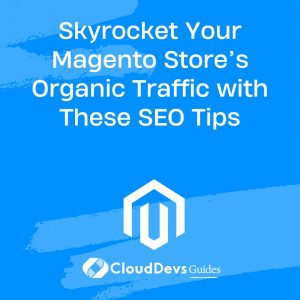Skyrocket Your Magento Store’s Organic Traffic with These SEO Tips
Magento, a popular e-commerce platform, offers robust features that can help online store owners establish a strong online presence. However, while Magento does have built-in SEO capabilities, store owners need to ensure that they’re maximizing these functionalities and implementing best practices to boost organic traffic. In this guide, we’ll explore essential SEO tips specifically tailored for Magento e-commerce websites.
1. Optimize Product URLs
By default, Magento might generate URLs for your products that look something like this: `http://www.yourstore.com/catalog/product/view/id/50`. These are not very SEO-friendly.
Tip: Ensure you have ‘Web Server Rewrites’ turned on in System > Configuration > Web > Search Engine Optimization. This will remove the `index.php` from the URLs, and then, in the same section, set “Use Categories Path for Product URLs” to “No” to prevent super long URLs.
Example: Transforming the above URL to `http://www.yourstore.com/product-name` makes it cleaner and more keyword-rich.
2. Use Canonical Tags
Sometimes, having multiple URLs pointing to the same content can lead to duplicate content issues. Magento provides a built-in option for canonical tags that can point search engines to the original version of the page.
Tip: Navigate to System > Configuration > Catalog > Search Engine Optimizations and enable canonical links for products and categories.
3. Optimize Product Descriptions and Titles
Avoid using manufacturer’s product descriptions. Search engines may see this as duplicate content if other retailers use the same descriptions.
Example: If you’re selling a “Blue Linen Shirt”, instead of the generic title “Blue Shirt”, try “Men’s Handcrafted Blue Linen Shirt – [Your Brand]”.
4. Utilize Magento’s XML Sitemap
An XML sitemap aids search engines in crawling and indexing your site’s pages.
Tip: To create an XML sitemap in Magento, navigate to System > Configuration > Google Sitemap. Here, set the frequency and priority for various page types. After configuring, generate the sitemap by going to Catalog > Google Sitemap > Add Sitemap.
5. Mobile Optimization
Ensure that your Magento site uses a responsive theme. Google has made mobile-friendliness a ranking factor, so optimizing for mobile users is crucial.
Example: Use Magento themes like Porto, Ultimo, or Fortis that are mobile-responsive out of the box.
6. Improve Site Speed
A slow-loading site can harm your SEO rankings. Use caching mechanisms, reduce image sizes, and consider using a Content Delivery Network (CDN).
Tip: Tools like Google’s PageSpeed Insights can offer specific advice on speeding up your Magento site.
7. Add Rich Snippets
Rich snippets provide more information about a particular page. For e-commerce sites, this can include product ratings, prices, and availability.
Example: If a user searches for “Blue Linen Shirt”, a result with a rich snippet might show a 4.5-star rating, a price of $50, and an “In Stock” notification.
8. Optimize Images
Images can significantly affect page load times. Ensure they are compressed without compromising quality. Also, use descriptive file names and alt tags.
Example: Instead of `shirt.jpg`, use `blue-linen-shirt-mens.jpg` and an alt tag like “Men’s Blue Linen Shirt”.
9. Utilize H1, H2 Tags
Ensure that each page has one H1 tag, usually the page or product title. Use H2, H3 tags for subheadings.
Tip: A product page might have the product name as the H1 tag, with “Product Description”, “Customer Reviews”, etc., as H2 tags.
10. Implement HTTPS
Google views secure websites (those starting with HTTPS) more favorably. Ensure your Magento store uses an SSL certificate.
11. Optimize Your Internal Link Structure
Use relevant anchor texts for internal links, and ensure that important pages are no more than three clicks away from the homepage.
Example: If you’re writing a blog post about summer fashion, link to related products with anchor texts like “linen shirts for summer” or “summer footwear collection”.
12. Avoid Duplicate Content
Magento sites can sometimes generate duplicate content due to filter and category combinations. Use the canonical tag feature mentioned earlier, and consider using robots.txt to block areas of the site that create duplicate content.
Conclusion
SEO for Magento e-commerce websites might require meticulous attention to detail, but the payoff is well worth it. Implement these tips and regularly monitor your site’s performance. With time and effort, your Magento store can achieve higher rankings, leading to more organic traffic and increased sales.
Table of Contents







